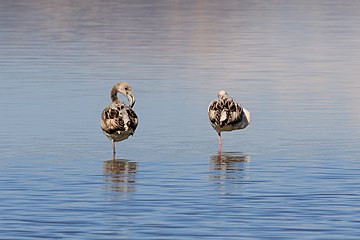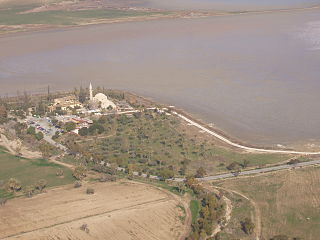geo.wikisort.org - Reservoir
Larnaca Salt Lake (Greek: Αλυκή Λάρνακας, Turkish: Larnaka Tuz Gölü) is a complex network of four salt lakes (3 of them interconnected) of different sizes to the west of the city of Larnaca. The largest is lake Aliki, followed by lake Orphani, lake Soros and lake Spiro.[3] They form the second largest salt lake in Cyprus after the Limassol Salt Lake. The total surface area of the lakes adds up to 2.2 km2 and being just off the road leading to Larnaca International Airport is one of the most distinctive landmarks of the area. It is considered one of the most important wetlands of Cyprus and it has been declared a Ramsar site, Natura 2000 site, Special Protected Area under the Barcelona Convention[4] and an Important Bird Area (IBA).[5] It is surrounded by halophytic scrubland and on its bank lies the Hala Sultan Tekke, one of the holiest of shrines within Ottoman Islam. It houses the tomb of Umm Haram, Muhammad's 'wet-nurse'.
| Larnaca Salt Lake | |
|---|---|
 in winter with part of Larnaca city in the background. | |
| Coordinates | 34°54′N 33°37′E |
| Basin countries | Cyprus |
| Surface area | 1,585 ha (3,920 acres)[1] |
| Average depth | 1 m (3 ft 3 in) |
| Surface elevation | 0 m (0 ft) |
| Settlements | Larnaca |
| References | [1] |
Ramsar Wetland | |
| Designated | 11 July 2001 |
| Reference no. | 1081[2] |
Besides its picturesque beauty, the lake is the haunt of 85 species of water-birds with estimated populations between 20,000 and 38,000.[citation needed] It is one of the important migratory passages through Cyprus. Among them are 2,000–12,000 flamingoes (Phoenicopterus roseus)[6] which spend the winter months there feeding off populations of the brine shrimp Artemia salina.[3] Other important bird species are Grus grus, Charadrius alexandrines, Larus ridibundus, Himantopus himantopus, Burhinus oedicnemus, Hoplopterus spinosus, Oenanthe cypriaca and Sylvia melanothorax.[citation needed] Flocks of birdwatchers gather to observe the blaze of pink from flamingoes as they gather in the centre of the lake but also the other important migrants. The Larnaca Salt Lake complex was declared as a protected area by a decision of the Council of Ministers in 1997.[7] Recent evidence suggests that contrary to previous belief the greater flamingo (Phoenicopterus roseus) not only stops over but also breeds on this wetland.[8]
During the winter months the lake fills with water while in the summer the water evaporates, leaving a crust of salt and a haze of grey dust. According to legend, the lake's saltiness stems from St Lazarus' request of an old woman for food and drink. She refused, claiming her vines had dried up, to which Lazarus replied: "may your vines be dry and be a salt lake forever more."[9] A more scientific explanation is that the salt water penetrates the porous rock between the lake and the sea, making the water very salty.[citation needed]
Salt harvested from this lake used to be one of the island's major exports, being collected with donkeys, carried to the edge of the lake, and piled up into huge pyramidal heaps. With rising labour costs harvesting dwindled to a negligible amount and stopped altogether in 1986[3] as the island now imports most of this commodity.[citation needed]
Gallery
- Flamingos on the lake
- Aerial photo of the Larnaca Salt Lake (in winter) with Hala Sultan Tekke
References
- "The Annotated Ramsar List: Cyprus". Ramsar Convention Secretariat. 24 August 2001. Archived from the original on 29 June 2008. Retrieved 6 June 2016.
- "Larnaca Salt Lake". Ramsar Sites Information Service. Retrieved 25 April 2018.
- "Report of the environmental audit of the city of Larnaca" (PDF). Medcities. May 1999. Retrieved 2007-03-29.
- Kassinis, Nicolaos; Michalis Antoniou (October 2006). "Proceedings of the first symposium on the Mediterranean action plan for the conservation of marine and coastal birds (p94)" (PDF). Archived from the original (PDF) on September 29, 2007. Retrieved 2007-03-29.
- Iezekiel S., Makris C., Antoniou A. (2004) Important Bird Areas of European Union Importance in Cyprus. Birdlife Cyprus, Lefkosia 2004.
- "BirdLife IBA Factsheet - Larnaca salt-lake". BirdLife International. 2006. Retrieved 2007-03-25.
- Hadjichristoforou, Myroula (8 December 2004). "5th European Regional Meeting on the implementation and effectiveness of the Ramsar Convention" (PDF). Ramsar. Archived from the original (PDF) on January 6, 2006. Retrieved 2007-03-25.
- Hadjisterkotis, E.; M. Charalambides (September 30, 2005). "The first evidence for the breeding of the Greater FlamingoPhoenicopterus ruber on Cyprus (Erster Brutnachweis des Flamingos Phoenicopterus ruber auf Zypern)". Zeitschrift für Jagdwissenschaft. 48 (Supplement 1): 72–76. doi:10.1007/BF02192394.
- "Saint Lazare in Larnaca". Damianos Foundation. Archived from the original on 2007-09-30. Retrieved 2007-04-16.
External links
 Media related to Larnaca Salt Lake at Wikimedia Commons
Media related to Larnaca Salt Lake at Wikimedia Commons
На других языках
[de] Salzsee von Larnaka
Der Salzsee von Larnaka (griechisch: Αλυκή Λάρνακας, türkisch: Larnaka Tuz Gölü) befindet sich auf der Insel Zypern. Er ist eigentlich ein System von vier Salzseen, von denen drei miteinander verbunden sind. Der größte der vier Seen ist der Aliki-See, danach folgt der Orphani-See, dann der Soros-See und schließlich der Spiro-See. Mit einer Gesamtoberfläche von etwa 2,2 km² ist er etwa zwei Drittel kleiner als der Limassol Salt Lake, der zweite Salzsee auf Zypern. Der See gilt als ein Wahrzeichen der Region.- [en] Larnaca Salt Lake
[es] Lago salado de Lárnaca
El lago salado de Lárnaca (en griego, Αλυκή Λάρνακας) queda al oeste de la ciudad de Lárnaca. Es una compleja red de cuatro lagos salados (3 de ellos interconectados) de diferentes tamaños. El lago más grande es el lago Aliki seguido por el lago Orphani, el lago Soros y el lago Spiro.[2] Forman el segundo lago salado por tamaño en Chipre después del lago salado de Limasol. La superficie total de los lagos añade 2,2 km² y que estando justo frente a la carretera que lleva al Aeropuerto Internacional de Lárnaca es uno de los más señalados hitos de la zona. Está considerado uno de los más importantes humedales de Chipre y ha sido declarado sitio Ramsar, sitio Natura 2000, área de especial protección bajo el Convenio de Barcelona.[3] y una zona importante para aves (IBA).[4] Está rodeado por zona arbustiva halófita y a sus espaldas queda el Hala Sultan Tekke, uno de los más sagrados santuarios dentro del Islam otomano. Alberga tumba de Umm Haram, nodriza de Mahoma.[ru] Ларнака (озеро)
Ла́рнака[2][3][4] (греч. Αλυκή Λάρνακας) — солёное озеро у южной окраины одноимённого города Республики Кипр[1], одно из важнейших на Кипре и в Европе мест зимовки птиц[2]. Здесь останавливаются стаи фламинго, диких уток и иных водоплавающих[5]. Представляет собой сложную сеть из четырёх солёных озёр, три из них соединены между собой. Самым большим из них является озеро Алики, за ним следуют озеро Орфани, озеро Сорос и озеро Спиро. Ларнака — второе по величине солёное озеро на Кипре после солёного озера Лимасол. Озеро считается одним из самых важных водно-болотных угодий Кипра и было объявлено (с 2001 года) Рамсарским угодьем[6], участком Натура 2000, Особой охраняемой территорией в соответствии с Барселонской конвенцией и важной орнитологической зоной (IBA). Озеро окружено галофитными кустарниками, а на его берегу находится Мечеть Хала Султан Текке, одна из святынь ислама. Здесь находится гробница Умм Харам, кормилицы Мухаммеда.Другой контент может иметь иную лицензию. Перед использованием материалов сайта WikiSort.org внимательно изучите правила лицензирования конкретных элементов наполнения сайта.
WikiSort.org - проект по пересортировке и дополнению контента Википедии


